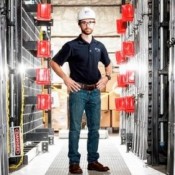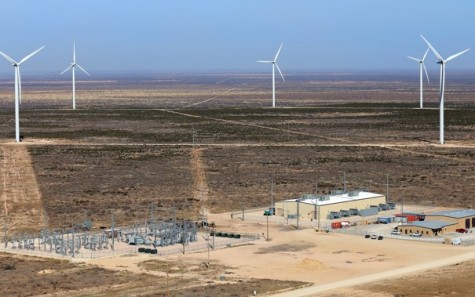As more and more wind power has been built in Texas (greater than any other state), when wind turbines delivered a record 10,296 MW to the ERCOT grid on March 26, another new grid technology was waiting to respond as it sat next to the sprawling 150 MW Notrees wind farm in west Texas. This is where one of the world's largest grid battery facilities had been operating for a year.

Built for Duke Energy by Xtreme Power (recently purchased in bankruptcy by Berlin-based Younicos), the 36 MW array can respond within seconds and deliver stored wind power for 15 minutes throughout the Texas grid. Although the primary job of battery storage is to eliminate wind and solar intermittency, it turns out that instant response is a big advantage. Historically, ERCOT has relied on natural gas-powered turbines to regulate transmission line frequency, but because turbines take minutes to respond, Xtreme's batteries now show up first to provide this profitable niche service. After monitoring the project for a year, Duke Energy said, "The speed and accuracy of the system's response confirmed the benefits of the Notrees Battery Storage Project and ERCOT has made it a permanent market service."
Fortnightly's Power Profit (see the whole interview) spoke with Jeff Gates, managing director in Duke Energy's commercial transmission business, about the Notrees results and the future of battery storage.
Gates: ...One of the key strengths of storage delivery is that it's so much faster and more accurate. If the system frequency level moves to one side of 60 Hz or the other, ERCOT will send a signal to increase or decrease output. A conventional power plant can take several minutes to ramp to the new output level, so the grid operator has plants that are chasing the signal. By the time they reach their new dispatch level, the grid operator may actually want them doing just the opposite. With storage we're not chasing the signal, because the battery can respond with full output within less than a second.

FPP How often have [you] delivered power for frequency regulation?
Gates: I would say roughly six to 10 deployments per hour.
FPP: How else might the technology be employed?
Gates: We've done some dispatch into the ERCOT energy market during peak periods when prices are high. But the price differential usually isn't high enough to do that on a regular basis. During the cold snap in January, 2014, spot prices were in the thousands of dollars, so it certainly made sense to take advantage of that.
That's where we're heading with storage. To use storage only for what conventional generators do doesn't tap its true value.
FPP And what is its true value?
Gates: Flexibility and reliability are probably the two biggest values. Storage is very flexible in terms of ramp control, and that's a big issue in California right now. In California, you have a huge amount of PV coming on all at once as the sun comes up in the morning. So you have to ramp down the conventional generation that's been on-line overnight. And at the end of the day, as the PV generation starts to fall off, you have to transition from PV back to conventional generation. Storage is ideally suited to support that morning-evening transition.
Another benefit is siting flexibility. You can place storage close to load centers, or on the right side of a transmission constraint. Not everyone wants to live next to a fossil plan.
FPP: In September Duke announced it will add another 400 MW of wind capacity at its Los Vientos plant in Texas. Any plans for including storage there?
Gates: We're always looking to install storage where it makes sense, but that's really a market-design question... in a market like ERCOT, it's difficult to add storage to an integrated renewables project because the cost-recovery mechanism is in two different buckets.
Hawaii or Puerto Rico, which have very small island grids, in markets like that the rules require storage to be part of a renewable project. You must deliver ramp control and firm output to connect to the grid because a large renewable project on a small grid could cause major stability problems.
In California, rather than impose the burden on the generator, they're developing a market mechanism that will incentivize fast ramping resources. They're basically telling generators if they can provide the flexibility of fast ramping, then the ISO will have a ramping product specifically for that.
In the Carolinas, where Duke controls the entire value chain from generation through to the end customer, there are no price signals for frequency regulation or flexibility. So the way a vertically integrated utility looks at the issue is different from an IPP in a market like ERCOT.


